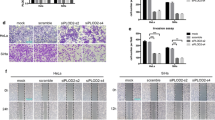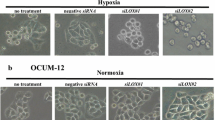Abstract
The effects of hypoxia on the invasion and the related protein expression of Hela cells and the role of hypoxia inducible factor-1α (HIF-1α) were investigated. The Hela cells were divided into three groups, namely, H0 (non-transfected Hela cells), H1 (pGenesil-1 empty plasmid-transfected Hela cells), and H2 (HIF-1α-shRNA plasmid-transfected Hela cells), and were cultured under hypoxia (1% O2) and normoxia for 48 h. The expression of HIF-1α, E-cadherin, β-catenin, and actin was detected using Western blot. The scratch test and the invasion assay were applied to examine the invasion in each group. The expression of HIF-1α, E-cadherin, and β-catenin in tumor grafts was assayed immunohistochemically. Western blot results revealed that the bands of HIF-1α, E-cadherin, β-catenin, and actin proteins were detected in the H0 and H1 groups under hypoxia for 48 h. The expression of Ecadherin, β-catenin, and actin was detected in the H2 group under hypoxia for 48 h, and normoxia. In the H0, H1, and H2 groups under normoxia, and the H2 group under hypoxia for 48 h, no expression of HIF-1α was detectable. The scratch test showed that the invasive ability in the H2 group was significantly alleviated. Immunohistochemically, it was found that there was a significant difference in the expression of HIF-1α, E-cadherin, and β-catenin between the H1 and H2 groups (P<0.05), but the difference was not significant between the H0 and H1 groups. It was concluded that the effects of hypoxia on the invasion of human cervical cancer Hela cells and the expression of related proteins (E-cadherin, β-catenin, and actin) depend on HIF-1α.
Similar content being viewed by others
References
Fidler I J. The pathogenesis of cancer metastasis: the seed and oil hypothesis revisited. Nat Rev Cancer, 2003, 3(6): 453–458
Rivard N. Phosphatidylinositol 3-kinase: a key regulator in adherent junction formation and function. Front Biosci, 2009, 14: 510–522
Sonq Y, Wang W, Qu X, Sun S. Effects of hypoxia inducible factor-1alpha (HIF-1alpha) on the growth & adhesion in tongue squamous cell carcinoma cells. Indian J Med Res. 2009, 129(2): 154–163
Song I S, Wang A G, Yoon S Y, Kim J M, Kim J H, Lee D S, Kim N S. Regulation of glucose metabolism-related genes and VEGF by HIF-1alpha and HIF-1beta, but not HIF-2alpha, in gastric cancer. Exp Mol Med, 2009, 41(1): 51–58
Yuan X L, Yu S L, Zhuang L, Xie T, Yang B, Dong L L, Xiong H. Interference of HIF-1α by RNA to enhance radio sensitivity of HeLa cell tumor transplanted in BALB/c mice. Zhongguo Aizheng Zazhi, 2007, 17(4): 303–306 (in Chinese)
Sambrook J, Russell D W. The Condensed Protocols from Molecular Cloning: a Laboratory Manual (in Chinese, trans. Huang Peitang). 3rd ed. Beijing: Science Press, 2002
Escuin D, Simons JW, Giannakakou P. Exploitation of the HIF axis for Cancer Therapy. Cancer Biol Ther, 2004, 3(7): 608–611
Fidler I J, Kim S J, Langley R R. The role of the organ microenvironment in the biology and therapy of cancer metastasis. J Cell Biochem, 2007, 101(4): 927–936
Luo Y, He D L, Ning L. Hypoxia-inducible factor-1alpha induces the epithelial mesenchymal transition of human prostatecancer cells. Chin Med, 2006, 119(9): 713–718
Ma J, Zhang L, Ru G Q, Zhao Z S, Xu WJ. Upregulation of hypoxia inducible factor 1alpha mRNA is associated with elevated vascular endothelial growth factor expression and excessive angiogenesis and predicts a poor prognosis in gastric carcinoma. World J Gastroenterol, 2007, 13(11): 1680–1686
Cardone R A, Bellizzi A, Busco G, Weinman E J, Dell’Aquila M E, Casavola V, Azzariti A, Mangia A, Paradiso A, Reshkin S J. The NHERF1 PDZ2 domain regulates PKA-RhoA-p38-mediated NHE1 activation and invasion in breast tumor cells. Mol Biol Cell, 2007, 18(5): 1768–1780
Wojciak-Stothard B, Tsang L Y, Paleolog E. Hall S M, Harworth S G. Rac1 and RhoA as regulators of endothelial phenotype and barrier function in hypoxia-induced neonatal pulmonary hypertension. Am J Physiol Lung Cell Mol Physiol, 2006, 290(6): L1173–1182
Aono Y, Ariyoshi H, Tsuji Y, Ueda A, Tokunaga M, Sakon M, Monden M. Localized activation of m-calpain in human umbilical vein endothelial cells upon hypoxia. Thtomb Res, 2001, 102(4): 353.361
Nelson W J, Nusse R. Convergence of Wnt, beta-catenin, and cadherin pathways. Science, 2004, 303(5663): 1483.1487
Menez J, Le Maux Chansac B, Dorothee G, Vergnon I, Jalil A, Carlier M F, Chouaib S, Mami-Chouaib F. Oncogene, 2004, 23 (15): 2630–2639
Calvisi D F, Ladu S, Conner E A, Factor V M, Thorgeirsson S S. Disregulation of E-cadherin in transgenic mouse models of liver cancer. Lab Invest, 2004, 84(9): 1137–1147
Sun S, Ning X, Zhang Y, Lu Y, Nie Y, Han S, Liu L, Du R, Xia L, He L, Fan D. Hypoxia-inducible factor-1alpha induces Twist expression in tubular epithelial cells subjected to hypoxia, leading to epithelial-to-mesenchymal transition. Kidney Int, 2009, 75(12): 1278–1287
Yan W, Fu Y, Tian D, Liao J, Liu M, Wang B, Xia L, Zhu Q, Luo M. PI3 kinase/Akt signaling mediates epithelial-mesenchymal transition in hypoxic hepatocellular carcinoma cells. Biochem Biophys Res Commun, 2009, 2009, 382(3): 631–636
Hrroshi I, Hideyuki S, Masatoshi H. Expression of hypoxia inducible factor-1α predicts metastasis-free survical after radiation therapy alone in stage IIIB cervical squamous cell carcinoma. Int J Radiat Oncol Biol Phys, 2004, 50(4): 865–872
Ishikawa H, Sakurai H, Hasegawa M, Mitsuhashi N, Takahashi M, Masuda N, Nakajima M, Kitamoto Y, Saitoh J, Nakano T. Expression of Hypoxic-inducible factor-l alpha predicts metastasis-free survival after radiation therapy alone in stage IIIB cervical squamous cell carcinoma. Internat J Radia Oncol Phys, 2004, 60(2): 513–521
Bachtiary B, Schindl M, Potter R, Dreier B, Knocke T H, Hainfellner J A, Horvat R, Birner P. Overexpression of hypoxia inducible factor-1alpha indicates diminished response to radiotherapy and unfavorable prognosis in patients receiving radiotherapy for cervical cancer. Clin Cancer Res, 2003, 9(6): 2234–2240
Author information
Authors and Affiliations
Corresponding author
Rights and permissions
About this article
Cite this article
Yang, B., Yuan, X., Zou, Y. et al. Effects of hypoxia inducible factor-1alpha siRNA on the invasion of human Hela cells and expression of related proteins. Front. Med. China 3, 303–308 (2009). https://doi.org/10.1007/s11684-009-0060-3
Received:
Accepted:
Published:
Issue Date:
DOI: https://doi.org/10.1007/s11684-009-0060-3




